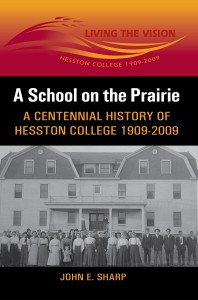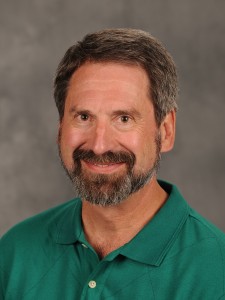John Sharp, Hesston College historian and faculty member, heard a quote about writing that he now understands for himself: “Writing is easy; just stare at the paper until drops of blood form on your forehead and fall onto the paper.” Or, in the words of Steve Martin, “I think I did pretty well, considering I started out with nothing but a bunch of blank paper.”
Sharp is the author of A School on the Prairie, A Centennial History of Hesston College 1909-2009 . The book will premier at Hesston College’s Centennial Homecoming Sept. 25-27, and is the product of four years of intense research, interviews, countless hours in archives, reading journals, and weaving the information into a book narrative.
“There is precious little romance in writing a book,” Sharp said. “It’s plain, hard work.”
Commissioned by Hesston College to write a book marking Hesston’s 100 years of serving the church and the world, Sharp began the writing process by exploring the archival collections in the basement of Mary Miller Library at Hesston College. He also traveled to Goshen, Indiana, to the Mennonite Church USA archives. Two sources there were of particular importance: the diaries of T.M. Erb and founding President D.H. Bender. Their daily record of activities and observations which they kept from the beginning to the end of their service in 1928 (Erb) and 1930 (Bender) added texture and color to the Hesston College story.
In addition, there were the minutes of Mennonite Board of Education (MBE) meetings and correspondence between MBE Executive Committee members and Hesston administrators. Also valuable were the personal collections and correspondences of Hesston personnel, such as Noah Oyer, who served as academic dean, and music faculty members Paul Erb and Alta Eby Erb.
The question of “Why?” came forward in Sharp’s mind as he studied the beginnings of the college. There were answers to why the founders started a college “in the West,” but why would people leave their fertile, well-established family farms in Pennsylvania? To find answers, Sharp explored the Pennsylvania origins of two of Hesston’s founders, T.M. Erb and A.L. Hess.
“I wanted to see the land and farms they left to move to Kansas,” he recalled. “The fertile limestone soil and the substantial stone and brick farm buildings were impressive. What did they gain by leaving? I found that the loss of the ancestral farms in Lancaster County was tempered by the lure of more affordable prairie land in Kansas and opportunities to create a new spiritual and social environment. Ironically, while Pennsylvania Mennonites never produced a college, the Pennsylvanians who migrated to Kansas did.”
Also in Pennsylvania, Sharp found useful information on the Hesses, Erbs, and J.D. and Millie Charles at the Lancaster Mennonite Historical Society; on former faculty member Mary Mensch Lederach at the Mennonite Heritage Center; and on first faculty member John B. Kanagy at the Mifflin County Mennonite Heritage Center.
He interviewed people at all of these places, and in Scottdale, Winifred Erb Paul, granddaughter of T.M. Erb, gave him access to four generations of family memory. In Goshen, he interviewed former MBE staff members; and at Hesston he met with dozens of former faculty, staff, board members, and alumni.
After gathering all the information he could collect, Sharp faced the challenge of sorting, sifting, and selecting material. Then came the creative task of weaving what he had chosen into the narrative. At the beginning, he wanted to include everything, and lots of context: Native American history, Kansas history, and Mennonite Church history. When Sharp’s wife Michelle read the first chapter, she said, “You can’t include it all.” John’s initial response was, “Watch me!
“But later, after writing a chapter of 50 pages single-spaced, I knew I was in trouble,” Sharp said. “So did Jim Juhnke on my editorial committee! At that pace, I could not possibly finish the book in time. I had to rethink my approach.”
Another challenging time was during the final sprint to rework citations, write photo captions, and upgrade photographs. Sharp had just returned from a trip to Central Asia and had begun his summer job of painting houses. In the first week, he took a spill from a ladder and landed on a sidewalk, injuring muscles and tendons in his hip, elbow, and neck. The bad news, and good news, was that he couldn’t paint for awhile. No longer divided between the two tasks of painting and wrapping up the book, he could focus entirely on the dash to the book deadline.
“Through it all, the erudite and able editor Michael King of Cascadia Publishing House, was an ideal task master,” Sharp said. “He guided the book through the perils of publishing to produce a first-rate product.”
Not bad, for starting out with a bunch of blank paper; or, in this case, a blank computer screen.
A School on the Prairie, A Centennial History of Hesston College 1909-2009 will premier at a book signing and reception on Friday, September 25 at 6:30 p.m. in Bontrager Student Center. Sharp will reflect on the process of writing the book, share stories from the narrative text, and have a question and answer time.
The book will be available for purchase and autograph signing by the author. The book will also be available for purchase at the Hesston College Bookstore both on campus and online (www.hesstonbooks.com) and through the Cascadia Publishing web site. It will become more widely available upon its November 1 release date.
“Glimpses of the School on the Prairie” is a DVD that is also available for purchase. It contains richly illustrated five-minute segments of each decade of Hesston College’s centennial history. The glimpses draw viewers into the text of the centennial book through 11 short videos, one for each decade, and one on the story of how Hesston College originated.



